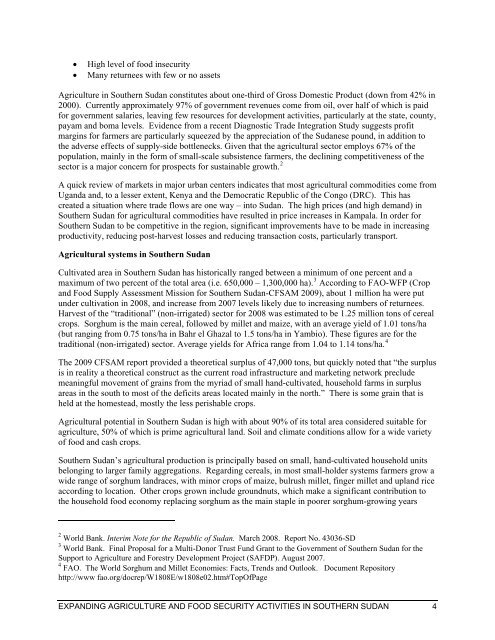expanding agriculture and food security activities in ... - part - usaid
expanding agriculture and food security activities in ... - part - usaid
expanding agriculture and food security activities in ... - part - usaid
You also want an ePaper? Increase the reach of your titles
YUMPU automatically turns print PDFs into web optimized ePapers that Google loves.
• High level of <strong>food</strong> <strong>in</strong><strong>security</strong><br />
• Many returnees with few or no assets<br />
Agriculture <strong>in</strong> Southern Sudan constitutes about one-third of Gross Domestic Product (down from 42% <strong>in</strong><br />
2000). Currently approximately 97% of government revenues come from oil, over half of which is paid<br />
for government salaries, leav<strong>in</strong>g few resources for development <strong>activities</strong>, <strong>part</strong>icularly at the state, county,<br />
payam <strong>and</strong> boma levels. Evidence from a recent Diagnostic Trade Integration Study suggests profit<br />
marg<strong>in</strong>s for farmers are <strong>part</strong>icularly squeezed by the appreciation of the Sudanese pound, <strong>in</strong> addition to<br />
the adverse effects of supply-side bottlenecks. Given that the agricultural sector employs 67% of the<br />
population, ma<strong>in</strong>ly <strong>in</strong> the form of small-scale subsistence farmers, the decl<strong>in</strong><strong>in</strong>g competitiveness of the<br />
sector is a major concern for prospects for susta<strong>in</strong>able growth. 2<br />
A quick review of markets <strong>in</strong> major urban centers <strong>in</strong>dicates that most agricultural commodities come from<br />
Ug<strong>and</strong>a <strong>and</strong>, to a lesser extent, Kenya <strong>and</strong> the Democratic Republic of the Congo (DRC). This has<br />
created a situation where trade flows are one way – <strong>in</strong>to Sudan. The high prices (<strong>and</strong> high dem<strong>and</strong>) <strong>in</strong><br />
Southern Sudan for agricultural commodities have resulted <strong>in</strong> price <strong>in</strong>creases <strong>in</strong> Kampala. In order for<br />
Southern Sudan to be competitive <strong>in</strong> the region, significant improvements have to be made <strong>in</strong> <strong>in</strong>creas<strong>in</strong>g<br />
productivity, reduc<strong>in</strong>g post-harvest losses <strong>and</strong> reduc<strong>in</strong>g transaction costs, <strong>part</strong>icularly transport.<br />
Agricultural systems <strong>in</strong> Southern Sudan<br />
Cultivated area <strong>in</strong> Southern Sudan has historically ranged between a m<strong>in</strong>imum of one percent <strong>and</strong> a<br />
maximum of two percent of the total area (i.e. 650,000 – 1,300,000 ha). 3 Accord<strong>in</strong>g to FAO-WFP (Crop<br />
<strong>and</strong> Food Supply Assessment Mission for Southern Sudan-CFSAM 2009), about 1 million ha were put<br />
under cultivation <strong>in</strong> 2008, <strong>and</strong> <strong>in</strong>crease from 2007 levels likely due to <strong>in</strong>creas<strong>in</strong>g numbers of returnees.<br />
Harvest of the “traditional” (non-irrigated) sector for 2008 was estimated to be 1.25 million tons of cereal<br />
crops. Sorghum is the ma<strong>in</strong> cereal, followed by millet <strong>and</strong> maize, with an average yield of 1.01 tons/ha<br />
(but rang<strong>in</strong>g from 0.75 tons/ha <strong>in</strong> Bahr el Ghazal to 1.5 tons/ha <strong>in</strong> Yambio). These figures are for the<br />
traditional (non-irrigated) sector. Average yields for Africa range from 1.04 to 1.14 tons/ha. 4<br />
The 2009 CFSAM report provided a theoretical surplus of 47,000 tons, but quickly noted that “the surplus<br />
is <strong>in</strong> reality a theoretical construct as the current road <strong>in</strong>frastructure <strong>and</strong> market<strong>in</strong>g network preclude<br />
mean<strong>in</strong>gful movement of gra<strong>in</strong>s from the myriad of small h<strong>and</strong>-cultivated, household farms <strong>in</strong> surplus<br />
areas <strong>in</strong> the south to most of the deficits areas located ma<strong>in</strong>ly <strong>in</strong> the north.” There is some gra<strong>in</strong> that is<br />
held at the homestead, mostly the less perishable crops.<br />
Agricultural potential <strong>in</strong> Southern Sudan is high with about 90% of its total area considered suitable for<br />
<strong>agriculture</strong>, 50% of which is prime agricultural l<strong>and</strong>. Soil <strong>and</strong> climate conditions allow for a wide variety<br />
of <strong>food</strong> <strong>and</strong> cash crops.<br />
Southern Sudan’s agricultural production is pr<strong>in</strong>cipally based on small, h<strong>and</strong>-cultivated household units<br />
belong<strong>in</strong>g to larger family aggregations. Regard<strong>in</strong>g cereals, <strong>in</strong> most small-holder systems farmers grow a<br />
wide range of sorghum l<strong>and</strong>races, with m<strong>in</strong>or crops of maize, bulrush millet, f<strong>in</strong>ger millet <strong>and</strong> upl<strong>and</strong> rice<br />
accord<strong>in</strong>g to location. Other crops grown <strong>in</strong>clude groundnuts, which make a significant contribution to<br />
the household <strong>food</strong> economy replac<strong>in</strong>g sorghum as the ma<strong>in</strong> staple <strong>in</strong> poorer sorghum-grow<strong>in</strong>g years<br />
2 World Bank. Interim Note for the Republic of Sudan. March 2008. Report No. 43036-SD<br />
3 World Bank. F<strong>in</strong>al Proposal for a Multi-Donor Trust Fund Grant to the Government of Southern Sudan for the<br />
Support to Agriculture <strong>and</strong> Forestry Development Project (SAFDP). August 2007.<br />
4 FAO. The World Sorghum <strong>and</strong> Millet Economies: Facts, Trends <strong>and</strong> Outlook. Document Repository<br />
http://www fao.org/docrep/W1808E/w1808e02.htm#TopOfPage<br />
EXPANDING AGRICULTURE AND FOOD SECURITY ACTIVITIES IN SOUTHERN SUDAN 4

















